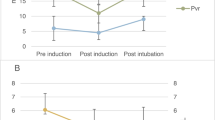Abstract
Background: The effects of carbon dioxide pneumoperitoneum on venous return and cardiac hemodynamics during laparoscopic surgery were studied.
Methods: Twelve adult pigs underwent placement of an electromagnetic flow meter across the infrarenal vena cava (IVC) as well as placement of Swan Ganz and arterial monitoring catheters. Measurements of the flow through infrarenal IVC, cardiac output (CO), pulmonary capillary wedge pressure (PCWP), mean arterial pressure (MAP), and heart rate were recorded at baseline, 5 and 60 min following insufflation to 15 mmHg with CO2, and 5 min following desufflation. Stroke volumes and systemic vascular resistance (SVR) were calculated as well.
Results: Flow through the IVC dropped by 24 and 31% at 5 and 60 min (p=0.03 and 0.02, respectively). Paradoxically, cardiac output rose by 14 and 28% at 5 and 60 min (p=0.03 at 60 min). Central venous and pulmonary capillary wedge pressures rose transiently by 35 and 36% at 5 min before returning to baseline (p<0.01). Mean arterial pressure and heart rate remained relatively constant during insufflation. Systemic vascular resistance diminished from 938 dynes/cm/s prior to insufflation to its nadir at 60 min of 650 dynes/cm/s (p<0.01).
Conclusions: These observations suggest potentially complex interactions between the mechanical and systemic effects of the CO2 pneumoperitoneum on venous return. Transient elevations in cardiac filling pressures occur by an unknown mechanism, and a generalized enhanced inotropic state mediated via increased sympathetic outflow is observed in this hypercapnic anesthetized animal model.
Similar content being viewed by others
References
Critchley LA, Critchley JA, Gin T (1993) hemodynamic changes in patients undergoing laparoscopic cholecystectomy: measurement by transthoracic electrical bioimpedance. Br J Anaesth 70(6): 681
Cunningham AJ, Turner J, Rosenbaum S, Rafferty T (1993) Transesophageal echocardiographic assessment of haemodynamic function during laparoscopic cholecystectomy. Br J Anaesth 70(6): 621
Hashimoto S, Hashikura Y, Munakata Y, Kawasaki S, Makuuchi M, Hayashi K, Yanagisawa K, Numata M (1993) J Laparoendosc Surg 3(6): 535
Ho HS, Gunther RA, Wolfe BM (1992) Intraperitoneal carbon dioxide insufflation and cardiopulmonary functions. Laparoscopic cholecystectomy in pigs. Arch Surg 127(8): 928
Ishizaki Y, Bandai Y, Shimomura K, Abe H, Ohtomo Y, Idezuki Y (1993) Safe intraabdominal pressure of carbon dioxide pneumoperitoneum during laparoscopic surgery. Surgery 114(3): 549
Iwase K, Takenaka H, Yagura A, Ishizaka T, Ohata T, Takagaki M, Oshima S (1992) Endoscopy 24(9): 771
Joris JL, Noirot DP, Legrand MJ, Jacquet NJ, Lamy ML (1993) Hemodynamic changes during laparoscopic cholecystectomy. Anesth Analg 76(5): 1067
Kashtan J, Gree JF, Parsons EQ, Holcroft JW (1981) Hemodynamic effects of increased abdominal pressure. J Surg Res 30: 249
Kubota K, Kajiura N, Teruya M, Ishihara T, Tsusima H, Ohta S, Nakao K, Arizono S (1993) Alterations in respiratory function and hemodynamics during laparoscopic cholecystectomy under pneumoperitoneum. Surg Endosc 7(6): 500
Price HL (1960) Effects of carbon dioxide on the cardiovascular system. Anesthesiology 21(6): 652
Rasmussen JP, Dauchot PJ, DePalma RG, Sorensen B, Regula G, Anton AH, Gravenstein JS (1978) Cardiac function and hypercarbia. Arch Surg 113: 1196
Richardson DW, Wasserman AJ, Patterson JL (1978) General and regional circulatory responses to change in blood pH and carbon dioxide tension.
Sarfan D, Shambati S, Orland R (1993) Laparoscopy in high-risk cardiac patients. SGO 176: 598
Westerband A, Van De Water J, Amzallag M, Lebowitz PW, Nwasokwa ON, Chardavoyne R, Abou-Taleb A, Wang X, Wise L (1992) Cardiovascular changes during laparoscopic cholecystectomy. SGO 175(6): 535
Windeberger U, Siegl H, Woisetschlager R, Schrenk P, Podesser B, Losert U (1994) Hemodynamic changes during prolonged laparoscopic surgery. Eur Surg Res 26(1): 1
Author information
Authors and Affiliations
Rights and permissions
About this article
Cite this article
Ortega, A.E., Richman, M.F., Hernandez, M. et al. Inferior vena caval blood flow and cardiac hemodynamics during carbon dioxide pneumoperitoneum. Surg Endosc 10, 920–924 (1996). https://doi.org/10.1007/BF00188484
Received:
Accepted:
Issue Date:
DOI: https://doi.org/10.1007/BF00188484




